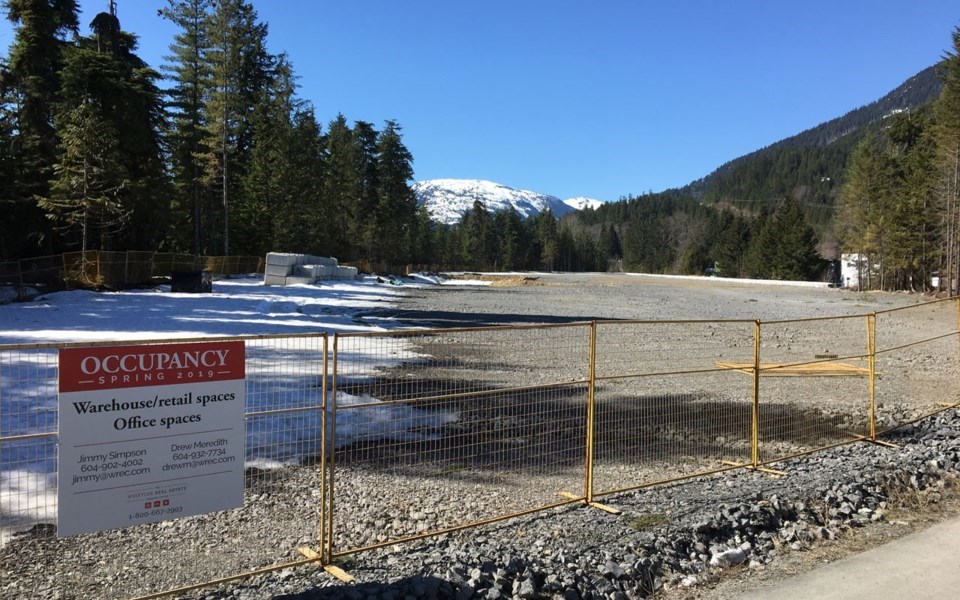Having worked in Function Junction for nearly a decade, I’ve taken a special interest in following the progress of the new development at the entrance to Whistler’s industrial neighbourhood—or, more accurately, the lack of progress.
I first wrote about the Lil’wat Nation’s plans for a mixed-use development—including a new gas station, office and commercial space, and employee housing—in October 2017, when Whistler’s mayor and council issued the first conditional* development permit for the work.
Since then I’ve driven past the empty site every morning longingly, wondering when we might finally see work get underway, every few months making a mental note to check in with the municipality, and the Lil’wat, and the provincial Ministry of Transportation and Infrastructure (MOTI) for an update.
And for years, the update was always some variation of the same: no comment.
But with a new DP issued by council on Feb. 8, it seems the lonely lot may finally see some activity.
At that first presentation way back in 2017, I had all the obvious questions about how the new development might impact traffic through the area. Some councillors had the same questions, and when they raised them, they were told a full traffic-impact study was completed for the project in the summer of 2017.
Nearly five years later, Pique still hasn’t seen the study (a 2018 Freedom of Information request was denied outright, while subsequent requests to see it were also rebuffed), but according to Lil’wat Nation CAO Kerry Mehaffey, the new development is expected to generate about five per cent more traffic.
To handle the increased traffic, MOTI and the Lil’wat have settled on a realignment of Lynham Road to create a new four-way intersection, along with an extension of the right-hand turn lane accessing Highway 99 heading southbound.
The extended right-hand turn will also feature a 110-metre southbound acceleration lane onto Highway 99 rather than the yield sign currently in place.
The Lil’wat and MOTI will split the roadwork responsibilities. The Nation will pick up the bill for the roadwork necessary to handle the increased traffic generated by the project.*
On paper, it looks manageable, but it remains to be seen how it all flows in practice.
While a shift in the timing of the light at Highway 99 some years back made a big difference, anyone who lives or works in Function knows how bad the 5 p.m. northbound traffic can sometimes get—particularly on a snowy Friday.
I do still have some (admittedly selfish) concerns about what the new development will mean for access/ingress from Function—and in particular the construction phase involved with modifying the road and highway—but the development itself is exciting, both for Whistler’s southern residents and the opportunities for the Lil’wat Nation.
The Nation acquired the lands through the Legacy Land Agreement of the 2010 Olympic and Paralympic Winter Games, and sees many positives in its development, both in terms of increasing its presence in Whistler and delivering new revenue for programs and services to community members.
Along with the service station (which Mehaffey has previously said will include space for EV chargers), the split-zoned site allows for light industrial uses, commercial services, professional office space, restaurants and employee housing—48 employee-restricted rental units, in this case, all of them desperately needed.
Some have questioned the foresight of installing a new gas station as B.C. pushes for increased EV adoption (the hope is that 100 per cent of all new light-duty vehicles sold in the province will be electric by 2035).
But most of us aren’t there yet, and won’t be for some time. When the time comes, gas stations can be converted, and incrementally so if necessary. For now, having another gas station in Whistler is welcomed, in my opinion.
The timing of the development, if years in the making, works well with the new housing going up across the highway in Cheakamus Crossing.
But the Resort Municipality of Whistler (RMOW) shouldn’t stop here. With hundreds of new homes being added to the Cheakamus neighbourhood, it’s time to start seriously considering adding new amenities for Whistler’s southern residents.
A grocery store, pharmacy, daycare spaces—anything local residents might need or want should be up for discussion as the build out of Cheakamus continues.
According to the RMOW, preliminary neighbourhood planning has taken place, with more to come, including “looking at neighbourhood-serving commercial services and amenities,” a spokesperson said.
These things have always been necessary, but the ongoing Whistler Transit strike has accentuated how isolated the neighbourhood really is from the rest of the resort.
The RMOW often talks about reducing highway traffic and cutting down on greenhouse gas emissions. Having fewer Cheakamus residents travelling north for basic amenities is a great place to start.
As it relates to traffic management, the impact of new development isn’t limited to Function; some have already raised concerns about Cheakamus’ lone entry/egress point, and what hundreds of new residents will do to traffic flows in and out of the neighbourhood—particularly in the event of an emergency.
Pique asked the RMOW if there is talk of adding a second entrance to the neighbourhood, but did not get a response before deadline.
As for Function, we’ll just have to trust that the flows will be manageable and the road readjustments will work as planned—because nobody will let us see the hard numbers for ourselves.
*This article has been updated from its original version to add additional information.




